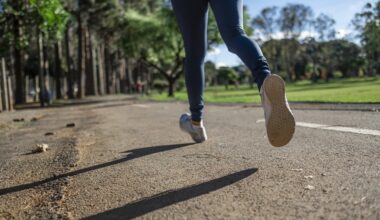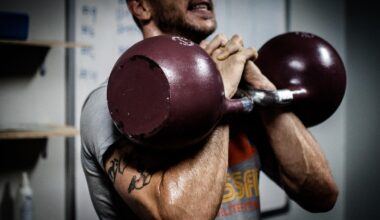Rowing for Weight Loss: A Beginner’s Guide
Rowing is an excellent way for beginners to achieve their weight-loss goals while enjoying a full-body workout. This popular sport not only helps shed pounds but also provides cardiovascular benefits and enhances muscle tone. Engaging in regular rowing sessions can significantly boost metabolism, leading to effective fat burning over time. Starting as a novice, it’s crucial to understand proper techniques and form to maximize both results and safety. Rowing machines offer an alternative for those unable to access watercraft, allowing for indoor training regardless of the elements outside. Setting achievable goals can keep you motivated throughout your journey. It’s key to create a balanced workout plan, mixing rowing sessions with strength training and flexibility exercises. Beginners should strive for consistency, aiming to row several times a week while gradually increasing their workout duration and intensity. Tracking your progress helps in keeping you accountable and motivated. Simple tools like a journal or fitness tracker can help mark improvements, ensuring you stay on course. With dedication and proper planning, rowing can become a fun and effective part of your weight-loss journey, leading to lasting health benefits.
To get started with rowing for weight loss, it’s essential to familiarize yourself with the different types of rowing machines available. Indoor rowing machines replicate the experience of rowing on water, providing an efficient alternative for beginners. There are various models, such as air, water, magnetic, and hydraulic resistance machines. Each type has its unique features and benefits, making it important to choose one that suits your workout style. For beginners, air resistance machines are popular for their smooth rowing experience and ability to adjust the intensity naturally based on your effort. When starting out, it’s advisable to incorporate workouts that focus on building endurance and strength, such as interval training. This approach will maximize calorie burn while improving overall fitness levels. Joining a local rowing club or taking classes from certified instructors can also fast track your learning process. These resources provide valuable guidance, help fine-tune your technique, and connect you with a community of fellow enthusiasts. Moreover, sharing your journey with others can lead to motivational support, which is crucial during challenging moments on your path to weight loss.
The Benefits of Rowing for Weight Loss
The benefits of rowing extend beyond just weight loss; they encompass numerous physical and mental health advantages as well. When compared to traditional cardio workouts, rowing is unique in that it engages multiple muscle groups, including the arms, legs, and core. This comprehensive engagement translates to higher calorie expenditure compared to exercises that target isolated areas of the body. Maintaining proper form during rowing protects against injuries while ensuring maximum output. Additionally, it improves your posture, resulting in increased overall well-being. Rowing can be incredibly rewarding; it provides a sense of accomplishment as you progress through various levels of intensity and distance. Many beginners find that incorporating rowing into their routines leads to improved mood and reduced stress levels. As a low-impact exercise, it is particularly suitable for individuals of all ages and fitness levels, allowing nearly anyone to participate comfortably. The rhythmic motion and focus required also serve as a form of meditation, offering a mental reset amid a busy life. Committing to rowing may lead to significant weight loss results while simultaneously enhancing physical and mental fitness.
Another key aspect of successful weight loss through rowing is establishing a well-rounded and nutritious diet. It’s important to remember that exercise alone will not lead to sustained weight loss; diet plays a critical role alongside your workout regimen. Focusing on whole foods, such as fruits, vegetables, lean proteins, and whole grains, will ensure your body receives the necessary nutrients to recover and perform efficiently. Keeping track of your caloric intake can assist in balancing the energy you expend through rowing with what you consume. Meal planning is a helpful approach to ensure you are consuming healthy options and avoiding impulse eating. Incorporating snacks like nuts or yogurt can provide the energy needed before and after rowing sessions. Furthermore, maintaining proper hydration is vital, especially during extended workouts. Dehydration can hinder performance, while drinking enough water keeps your body functioning optimally. Adjusting your food portions in line with your increased activity level will further support your weight-loss objectives. Remember that finding a dietary plan that suits your tastes and lifestyle is essential to adhere to it long-term.
Techniques for Effective Rowing
Learning the proper techniques for rowing is vital for maximizing workout effectiveness and minimizing injury risk. Early on, concentrate on mastering your stroke mechanics, which include leg drive, body swing, and arm pull. Proper rower technique begins with engaging your legs, pushing off from the foot stretchers as you extend your legs fully. As your legs straighten, lean slightly backward, ensuring your core remains stable. Pull your arms to your chest while maintaining a straight posture, and then release in a controlled motion. Practicing these techniques can initially be challenging but will lead to significant improvements over time. Be sure to watch instructional videos or consult experienced rowers to refine your approach further. Many indoor rowing machines come equipped with workout programs that guide you through varying intensities and stroke rates. As you gain confidence in your row technique, begin introducing interval sessions to elevate your heart rate and enhance calorie burn. Consistent practice of these techniques will yield rewards, resulting in greater efficiency during workouts and more significant weight loss over time, making it essential for beginners to focus on form.
Another vital element of rowing for beginners is setting realistic and achievable goals. Establish manageable milestones that guide you on your weight-loss journey while keeping you motivated. Consider factors such as time commitment, fitness level, and personal preferences when creating these goals. Breaking your larger goal into smaller, more approachable targets can heighten your sense of achievement as you complete each milestone. For instance, aiming to row three times a week for twenty minutes initially allows for gradual progression. Afterward, increase the duration and intensity as you build endurance. It’s also essential to track your progress, whether by logging workouts, noting weight changes, or measuring body composition. Celebrate accomplishments on the way, reinforcing positive behavior that supports your efforts to reach your goals. Creating a workout schedule can help ensure consistency, allowing you to incorporate rowing into your daily routine. Additionally, consider utilizing an app to record and analyze your workouts. This process may help adapt your plan as you continue progressing while identifying areas that require focus. Ultimately, personal accountability and celebrating successes play a significant role in maintaining motivation and commitment.
Conclusion
In conclusion, rowing for weight loss offers an enjoyable and efficient workout option for beginners aiming to shed pounds. This versatile sport not only helps burn calories but also strengthens multiple muscle groups, promoting overall fitness benefits. Understanding the basic techniques, leveraging technology, and establishing a solid workout plan can set the foundation for long-term success. Always remember that pairing your workouts with a nutritious and balanced diet is crucial for optimal results on your weight loss journey. As you begin your rowing adventure, seek support from fellow rowers, local clubs, or fitness communities. Sharing experiences will provide motivation and encouragement as you navigate the challenges that arise. Stay flexible with your workout routine, and adapt as needed to prevent burnout and keep your workouts fresh. Commit to consistent progress while learning from setbacks, as they are part of any journey. With determination and patience, you can unlock the potential of rowing to not only lose weight but also enhance your overall well-being. The journey begins now; embrace the new lifestyle and allow rowing to transform you.
As you embark on this introductory exploration of rowing for weight loss, remember that every individual’s experience will differ. Take the time to discover what works best for you as you adapt your rowing sessions and dietary habits. With perseverance, rowing can become a long-lasting and enjoyable part of your fitness routine, leading to positive health outcomes and improved self-esteem. Start slowly, practice proper techniques, and stay committed— success will follow. Happy rowing!


